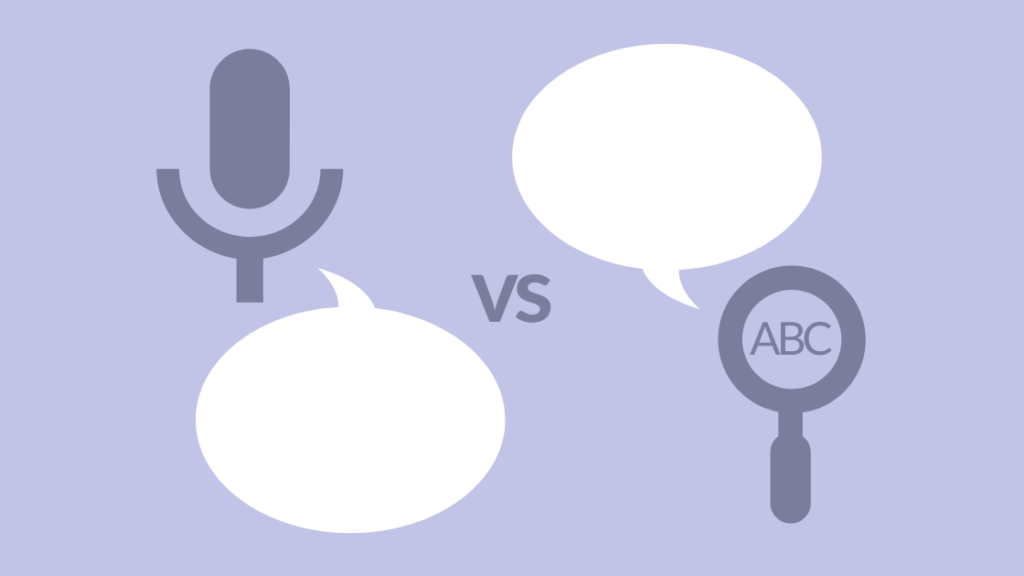Okay so picture this, you are attempting to make a nice meal for your visiting parents… You have the recipe sprawled out on the counter as you sacrifice your hand to dig for your stirring spoon that has yet again submerged into the bowl of mixture, and with your other free hand, you open the oven and remove the baking dish only to be met with the unmistakable smell of burntness. Tears start swelling up from either the onions you are chopping or realization that cooking is not your forte, and of course, there is flour everywhere (how exactly you don’t know, considering the recipe doesn’t even call for flour).
In the moment of defeat, you slump to the kitchen floor balancing the burnt dish and gripping the dripping spoon and utter, “Hey Siri…find a restaurant near me that has fast delivery”
What is voice search? And how is it different from text search?
From Siri to Alexa to Google to all the other voice assistants, the movement to voice search continues to ascend. It is no longer just an odd and amusing activity, it is a daily and convenient habit. In fact, voice search has become so normalized that people are conducting more voice search in public spaces, such as at restaurants, gyms, or public gatherings, therefore indicating how prevalent voice search has become. So popular that it‘s predicted in 2020 that 50% of searches with be managed by voice.
Voice search offers convenience and efficiency, and in a world dominated by multitasking the ability to search a query, call a friend, or play music without typing streamlines our daily lives. Voice search is fast, and speed is what we demand.
Below are three leading points on how voice search and text search differ.
1. Voice search is conversational, text search is concise

Voice search gives the feeling that you are talking to someone, therefore the way you phrase your query resembles that of a conversation. In contrast, when you type a search it typically is straightforward and concise. It does not reflect how you talk but rather the most efficient way to ask a question to receive the best result.
2. Voice search pulls one result, text search shows multiple

When conducting a voice search you often receive the direct response, such as the answer read back or the directions pulled up on your map app. Although for a traditional search, you are shown multiple resources that correspond to your search.
3. Voice search emphasis location at a higher rate than text search

Voice dominates location-based searches such as finding restaurants, hotels, or places to visit. In fact, “voice searches are three times more likely to be local-based than text search” since mobile devices are equipped for both voice search and locating listings.
As this trend reshapes the way search operates, Google has recently released an algorithm update that will improve results for voice searches. The algorithm change is called BERT.
What does BERT mean?

BERT, or “Bidirectional Encoder Representations from Transformers,” aims to increase Google’s understanding of how people speak. Since voice search is more conversational, the context of the search is significantly different than the context of a text search because it generates more words and intent that needs to be interpreted.
For example, voice search uses more signifying prepositions such as “for” or “to” that form the meaning of the query. With BERT, Google is able to interpret how these previously insignificant words provide extra context to the search, therefore allowing Google to improve its search results. BERT does more than clarify prepositions but gives additional meaning to word signals. For example, BERT enables Google to understand how the word “Adult” impacts the query, “Math practice books for adults.” The results before BERT would grasp the latter portion of the search and provide math books for students, although now with BERT Google understands the significance of “Adult” and provides more relevant results.
BERT will have a major impact on how Google translates queries and provides results since the update will impact 10% of Google searches. With the implementation of BERT, Google demonstrates that you need to optimize your website for voice search because as more people use a voice device, it determines how or if your website ranks.
How do you implement voice search optimization?
1. Focus on featured snippets

Featured snippets are the box of the information displayed at the top of Google’s results page. They are key pieces of information Google has prioritized as the most relevant results and clipped it to the top of the first page for users to easily find the answer or solution. In terms of voice search, the featured snippet is primarily used as the source when responding to queries.
While ranking for a featured snippet based on text search remains a competitive field, it has greatly elevated with the rise of voice search. Since voice search only returns one answer, the ability to hold that position is a powerful asset, and has been labeled as “position zero.” And more than often, position zero is the featured snippet. To learn more about optimizing featured snippets, please see here.
2. Properly structured data

To build on the previous point, structuring data so your website’s backend coordinates with Google’s bots will increase click-through rate, drive traffic, and enhance your competitiveness. Structuring data means adding schema markup so Google can efficiently and effectively analyze your website and determine how relevant your content is to the searched query.
3. Direct local SEO

As mentioned, voice search is widely used to conduct local searches, in fact on a weekly basis 75% of smart-speaker owners use the device to search for local businesses. These searches are often conducted using location-based keywords or specifically the phrase, “near me.” In order for Google to know that your business is in fact “near” someone, you need to tell it where you are located in the first place. This means incorporating keywords such as your city, neighborhood, states, etc. that allows your business to be recognized for a certain location. In addition, Google My Business is a powerful contributor for displaying and describing where and what your business does in order for Google to convey the information. To learn more about optimizing local SEO, please see here.
4. Understanding user intent

Understanding user intent means recognizing why someone is searching their question, therefore what they are looking for in the answer. While some intent is clear because the searcher uses keywords such as “price,” “how to,” or “what is,” other searches are much less obvious. By analyzing how people search relevant topics including question keywords or conversational expression, your business can start developing an analysis of what type of information is best suited for the user’s anticipated intent.
5. Adding voice search keywords

Since the way people conduct voice search resembles how they speak in a day-to-day manner, the inquiries are longer, therefore, increasing the length of keyword phrases. By targeting voice search keywords, the long-tail keywords decrease the competition and refine the topic allowing your business to rank for inquiries that directly relate to your content. Voice search keywords make the intent more clear and allow your business to create content that will resonate with that intent.
6. Incorporating questions

In addition to long-tail keywords, voice searches are often phrased as questions. For example, if you wanted to find the best brunch spots in your city, for a text search you would type, “best brunch in Minneapolis” while for voice search you would say, “What are the best brunch restaurants in Minneapolis?” While the intent is the same, the phrasing is different. Questions are a huge pattern among voice searches and should be incorporated within your content.
Furthermore, by structuring the content with the question as an H2 followed by a concise answer as the body text, it outlines the content in a clear and definite form that is easy for both the reader and Google to understand. And importantly, this structure supports a featured snippet style.
Some ways to implement questions on your website is including a FAQ page to highlight common questions phrased in a conversational manner. If you are targeting a popular question, try incorporating additional and related questions to further boost those topics. Other than researching online, reach out to customer service and ask for what common questions they receive.
7. Increase page speed

Another significant differentiator between voice and text search is page speed, with the average voice SERP loading 52% faster than the average website. As mentioned earlier, voice search is prevalent because it is geared towards convenience, and to be convenient you need to be fast, very fast. To learn how to increase page speed, please see here.
While desktop page speed is essential, since a majority of voice searches are on mobile, the need for fast mobile speed is critical, as well for an overall optimized mobile site.
8. Optimize for mobile

With around 20% of all searches on mobile being voice searches and an overall 56% of all voice searches being on a smartphone, mobile optimization is key. The ability for your website to perform well on mobile allows it to compete for that position zero while enabling a positive user experience. To learn more about mobile optimization, please see here.
So whether consumers use voice search to locate a “nearby restaurant that delivers” in order to salvage their family gathering or find any other products or services, ensuring your website is optimized for voice search offers ample advantages. While voice and text search may be similar there are distinct differences that make voice search optimization necessary, such as it reflects conversations, voice devices typically deliver a single result, and the emphasis on location-based searches. Google has even updated its algorithm to recognize the key differentiators between voice and text searches.
In order to optimize your website for voice search, you need to focus on featured snippets to be position zero and emphasis your businesses’ location by structuring data for Google bots and completing Google My Business information. In addition, analyzing user intent in coordination with long-tail keywords and questions guides how to create content that aligns with the user’s search. Since a majority of voice search is conducted via a mobile device, ensuring your website is optimized for mobile with a fast loading time will further maximize your voice search optimization. Each of these steps contributes to a website that reflects the evolving structure of online searches.







